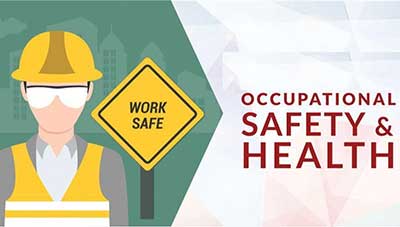Relevance: GS-3: Indian Economy and issues arising from it; Effects of liberalization on the economy, changes in industrial policy and their effects on industrial growth; Disaster and disaster management
Relevance:CRUSHED Report 2021, Labour Bureau, Directorate General, Factory Advice and Labour Institutes (DGFASLI), Occupational Safety, Health and Working Conditions Code 2020, Occupational Safety and Health Advisory Boards
Why in News?
- Recently, the CRUSHED Report 2021 released by Safe in India (SII), portrays a dismal picture concerning occupational safety and health in India.
- In India, occupational safety and health (OSH) has not received due attention from law-makers and even trade unions are very confused in this regard.
Key Highlights:
- In India, it is a fact that while industrial accidents occur often, only major accidents - say in construction or in a hazardous industry - are reported.
- Two primary requirements to ensure safe workplaces, viz. a strong monitoring (inspections) and comprehensive database to frame corrective actions and policies.
- Inspector-raj system's myth:
- While the pejorative term ‘inspector-raj’ is a crude exaggeration, there is some merit in the criticisms against the inspection system.
- Inspectors cannot feasibly inspect every factory, so they used their “discretion” to target the “easy” factories to demand compromising payments.
- Many of them belong to the powerful industry groups which have successfully lobbied against the inspection system.
Many shortcomings occupational safety and health governance in India:
- Skewed coverage and poor data collection:
- Statistics concerning industrial accidents are produced by the Labour Bureau. It compiles and publishes data on industrial injuries relating only to a few sectors, viz. factories, mines, railways, docks and ports.
- But the data suffer from skewed coverage. The Labour Bureau has not considered expanding the scope of statistics on injuries by adding sectors such as plantations, construction, the service sector, etc.
- Even the data it produces is not representative of the situation in India as several major States default in the provision of data to the Labour Bureau. For example, during 2013-14, several major States such as Delhi, Gujarat, Tamil Nadu, Uttar Pradesh and West Bengal defaulted.
- Computational Data Analysis of many states:
Analysis of Data of different states, we can make a scientifically proven statement that the reported figures for fatal injuries for all-India would be under-reporting by around 40%-50% and that for nonfatal injuries by at least 50%. - Massive under-reporting:
The SSI’s report, among others, shows massive under-reporting of industrial injuries occurring in many states. Its report covering a segment of the auto sector in Gurugram and Faridabad showed that since 2017, on average 500 workers have received nonfatal injuries. The under-reporting of industrial injuries, unlike for strikes and lockouts, is a far more serious issue and cause for grave concern. - Inadequate human resource for effective monitoring:
- According to the Directorate General, Factory Advice and Labour Institutes (DGFASLI)’s Standard Reference, the proportion of working in sanctioned posts for factory inspectors (employment rate) for India was 70.60%.
- Major States such as Maharashtra (38.93%), Gujarat (57.52%), Tamil Nadu (58.33%), and Bihar (47.62%) had poor employment rates of inspectors.
- In 2019, there was an inspector for every 487 registered factories: this reveals the heavy workload of inspectors. The inspector per 1,000 workers employed in factories is a meagre 0.04; put differently, there is an inspector for every 25,415 workers.
-
Decline in regular inspections and poor conviction rate:
- The proportion of registered factories inspected (inspection rates) for all-India declined from 36.23% during 2008-11 to 24.76%(2019-20) .
- While Kerala and Tamil Nadu had higher inspection rates at 63%-66%, Gujarat and Kerala had lower rates at 26%-30% and Haryana the lowest at 11.09% during 2008-2019.
- For all India, the conviction rates (percentage of convictions in total cases decided) for 2015-2019 stood at 61.39% and the average fine per conviction was ₹12,231 (not good enough to be a deterrent).
- However, the efficiency of the penal system is low as the percentage of decided cases out of total cases is a poor 15.74% during 2015-19.
Reasons identified:
- Mindless liberalization of the inspection system has not promoted sound labour market governance.
- Oversimplifying the annual returns and self-certification systems weakens the already poorly placed labour statistical system regarding all variables - especially industrial injuries - thanks to low reporting by firms to State labour departments and the latter to the Labour Bureau.
- Poor implementation of ratified International Labour Organization (ILO) conventions, the Labour Inspection Convention, 1947 (C081) and Labour Statistics Convention, 1985 (C160.
Key features of the Occupational Safety, Health and Working Conditions Labour Code 2020:
- Code will amalgamate 13 labour laws including the Factories Act, 1948; the Mines Act, 1952; the Contract Labour (Regulation and Abolition) Act, 1970 etc.
- All establishments covered by the Code must be registered with registering officers.
- The code provides for the setting up of Occupational Safety and Health Advisory Boards by the central and state governments at the national and state level.
- The Code expands the definition of a factory as a premise where at least 20 workers work for a process with power and 40 workers for a process without power.
- Appointment letters for all workers (including those employed before this code), underlying their rights to statutory benefits.
- Overtime work must be paid twice the rate of daily wages. Female workers, with their consent, may work past 7pm and before 6am, if approved by the central or state government.
- The employer is required to provide a hygienic work environment with ventilation, comfortable temperature and humidity, sufficient space, clean drinking water, and latrine and urinal accommodations.
Conclusion:
- Thus in order to resolve these concerns, the labour codes, especially the Occupational Safety, Health and Working Conditions Code, the inspection and the labour statistical systems should be further reviewed, as the Government is in the process of framing the Vision@2047 document for the long term planning of the labour market according to emerging needs of the economy.
Source: The Hindu BL
Mains Question
Q. “There is a need for a paradigm shift in how we view the labour market from a fixed employment provider to a flexible employment generator”. In this context, analyse the significance of four labour codes as an urgent reform to enable the labour market to expand according to the need of Industrial Revolution 4.0. Discuss. (15 marks)





















